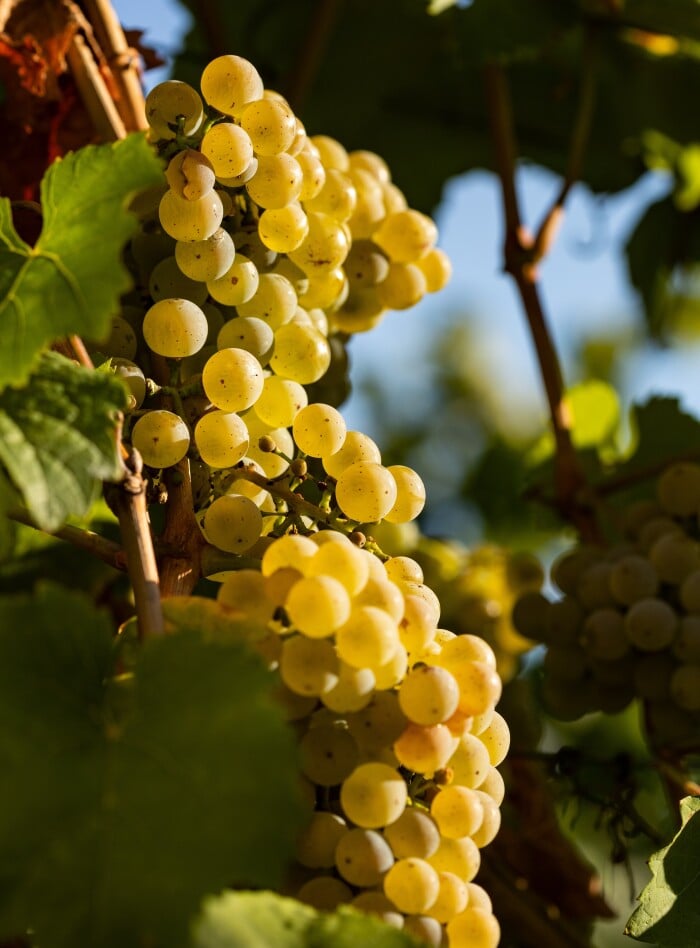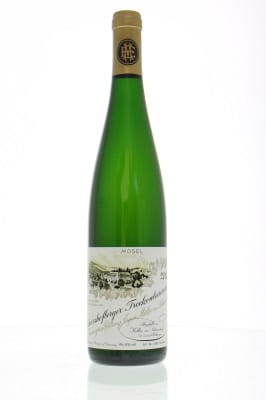
Riesling
Riesling: an aromatic masterpiece. If any grape variety deserves the title of terroir grape, it is undoubtedly Riesling. The white variety is the undisputed star in Germany, but it also produces great wines in Austria, Australia and the French region of Alsace.
In addition to the chardonnay, the riesling is also called a noble grape: it can produce the very best and most expensive wines in the world. Riesling wines can be very simple fresh wines when harvested early. But also very concentrated and extremely complex when harvested later, resulting in sweet(er) wines with for example sweet eiswein which is harvested in the winter.
Taste
Just like the sauvignon blanc wines, the riesling wines can be refreshing when having higher acidity: citrus flavours dominate. In the sweeter varieties, other fruit tones (pear, tropical fruit appear. The riper (older) riesling wines often develop a petroleum-like smell, which is very characteristic.
Where does the Riesling grape variety come from?
Given Germany's reputation when it comes to Riesling, it is only logical that the grape variety also has its original home here. The first evidence of the cultivation of vines, which were probably Riesling, can be found as early as the 9th century in the Rhine Valley under King Louis the German. The first written mention of it can be found in a document dated 13 March 1435 in Rüsselsheim am Main. That is why the birthday of Riesling is celebrated in Germany every year on this day.
In the 16th century, Riesling gradually spread throughout Germany. However, at that time it was mainly planted in mixed sets. It was not until 1720 that Riesling was planted exclusively in a vineyard at Johannisberg Castle in the Rheingau. In the 18th century, thanks to state funding from the Elector of Trier, the grape then arrived in the Moselle region. Other German wine-growing regions were added bit by bit. Today, Riesling is cultivated in all German wine regions and, with 24,000 hectares, accounts for around 24% of Germany's total vineyard area.
Riesling worldwide
German Riesling may be something of a model for enjoyment, but the grape also produces great wines in other countries. In particular, Austria and Australia have established themselves as important growing areas, each offering unique interpretations. In Austria, Riesling is the second most important white wine variety after Grüner Veltliner. Riesling is no less important in the French region of Alsace, which has repeatedly belonged to Germany over the centuries – and has accordingly adopted much of the German winemaking tradition.
Meanwhile, Australia has established itself as one of the leading countries outside of Europe that produces Riesling at the highest level. The cultivation area is about 3,114 hectares – and a large part of it can be found in the Eden Valley. Incidentally, the fact that Riesling exists in Australia at all is thanks to German immigrants who brought vines from their homeland in the 19th century. It was also German immigrants who brought Riesling to the United States, Canada and New Zealand.
What does Riesling taste like?
Precisely because Riesling is very much influenced by the terroir in which the grape variety grows, there is no single Riesling taste. Of course, the grape generally has a high acidity and many aromatic fruit tones. Typical notes include peach, lemon or green apple. Particularly ripe grapes also bring nuances of mango or pineapple to the wine. And many examples also shine with fine mineral notes. This is especially true for wines from the Moselle or the Nahe. Palatinate Rieslings, on the other hand, are fruity and quaffable, while wines from the Rheingau region impress with their full body. Matured Riesling can be reliably recognised by the distinct petrol note that develops over the years of storage.
And then there are the German Prädikat wine levels! Riesling is not only great as a dry wine, but also when it has a little residual sugar! The basic level, known as Riesling Kabinett, is particularly popular, with a lovely interplay of sweetness and acidity that delights the palate. Riesling Trockenbeerenauslese and ice wines are also among the longest-lasting wines in the world and offer a uniquely seductive and sweet taste experience that you will never forget.
Dry varieties are usually fresh and lively and have a pronounced acidity. Off-dry Rieslings are very harmonious and shine with a slight residual sweetness. The sweetness moderates the acidity and ensures a soft taste. Precisely because there is such a wide variety of Riesling, we like to recommend different drinking temperatures. A young and dry Riesling can be enjoyed slightly cooler at 8 to 10 °C, while a semi-dry or fruit-sweet wine is best served at between 10 and 12 °C so that the fruit is clearly perceptible. Complex Rieslings such as the Grand Crus and noble sweet varieties, however, are best served at a temperature between 12 and 14 °C.
What are the ideal growing conditions for Riesling?
Unfortunately, Riesling is not only versatile, but also quite demanding. It is precisely because it is so sensitive that it is able to convey the terroir on which it thrives so impressively. Since the grape likes to ripen slowly and over a long period, it prefers a cool to temperate climate. Fortunately, the grape variety buds late, so late frosts are usually not a problem for it. However, Riesling does not like it too hot either. When temperatures rise above 35 °C, it tends to suffer from sunburn. And rain before the harvest can result in the balance between acidity and fruitiness, for which Riesling is so famous, no longer being right.
Riesling thrives particularly well on steep slopes near rivers and lakes. Here it gets enough warmth and sun during the day to ripen reliably. In addition, the water stores the warmth, which means that the temperatures do not drop too drastically at night. That's something Riesling doesn't like either.
Which wine-growing regions are known for Riesling?
There is no question about it: Germany is the Riesling paradise par excellence. However, some regions here stand out in particular. And other countries also produce magnificent Riesling wines. Let's discover the best regions together at this point.
Moselle, Germany. The steep terraces on the Moselle are not only spectacular to look at – they are also home to the most sought-after Rieslings in the world. The wines enchant with a unique combination of freshness, acidity and minerality.
Rheingau, Germany. Limestone and slate provide ideal conditions for Riesling in the Rheingau. The proximity to the Rhine regulates temperatures and extends the growing season. Rheingau Rieslings are powerful, elegant and often vinified dry. They display aromas of citrus fruits, peach and floral notes.
Palatinate, Germany. No other wine region has planted as much Riesling as the Palatinate. A mixture of sandstone, limestone and loess ensures a wide range of taste profiles here. Palatinate Rieslings are usually full-bodied, fruity and accessible, with aromas of ripe stone fruit such as apricot or peach.
Wachau, Austria. Austria also has a Riesling El Dorado to offer in the form of the Wachau region. Here, the grape is cultivated in steep terraced vineyards along the Danube. Primary rock such as gneiss and granite characterise the mineral notes of the wines. Wachau Rieslings are concentrated, mineral and have a pronounced acidity. They display aromas of citrus fruits, apricot and exotic fruits.
Alsace, France. Alsace is the only wine-growing region in France where Riesling thrives. And that is only because the region has belonged to Germany from time to time over the centuries. The variety of soils – from limestone to granite to slate – ensures different styles. Alsatian Rieslings are usually dry, full-bodied and have aromas of citrus fruits, white flowers and mineral notes.
Which Riesling wines are famous?
What food goes well with Riesling?
Ah, here you can draw from an endless source! Would you like to enjoy a fresh and youthful Riesling? Then anything from the sea is the perfect match. From shrimp, mussels, sushi, but also salmon, pikeperch or sea bream, everything is a great accompaniment. Is the Riesling fruity? Then try grilled chicken, a papaya salad or a mild Thai curry with it! Do you like it spicy? Then the time has come for semi-dry and residual-sweet Rieslings. They are particularly delicious with spicy Thai curry or Korean dishes. But they also go well with really spicy chicken wings or a hearty curry sausage.
We've saved the best till last: Trockenbeerenauslese and ice wines made from Riesling are the perfect accompaniment to really sweet desserts! From apple strudel to crème brûlée and tarte tatin, anything goes. The same applies, of course, to chocolate mousse or chocolate cake. Yes, even creamy ice cream can be enjoyed with these fine Rieslings!
3 fun facts about Riesling
- The Moselle is the largest contiguous growing area for steep-slope Rieslings in the world.
- In the 19th century, German Rieslings were more expensive than Bordeaux wines.
- The name ‘Riesling’ could come from the word ‘Rusling’, which means dark wood.






